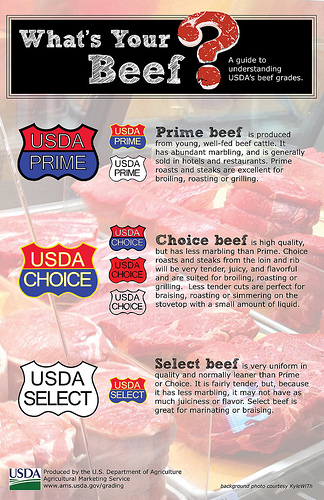
Rogue Creamery representatives display some of their popular cheeses during a 2011 international trade show in Hong Kong. The Oregon company credits the Foreign Agricultural Service’s (FAS) Market Access Program (MAP) and industry partners for helping the company expand international sales of its award-winning cheeses. (Courtesy Photo)
For 80 years, Rogue Creamery has been passionate about the art of cheese making. This small company located in Oregon’s scenic Rogue River Valley produces a variety of handcrafted artisan cheeses using milk from its dairies. Its blue cheeses are considered “ambassadors” for the American Artisan and Farmstead cheese movements. Rogue Creamery credits the Foreign Agricultural Service’s (FAS) Market Access Program (MAP) and industry partners for helping the company expand sales of its award-winning cheeses. Read more »

Family of three dines outdoors. ERS research found that among households that included an adult with a work-preventing disability, a third were food insecure in 2009-10.
This post is part of the Science Tuesday feature series on the USDA blog. Check back each week as we showcase stories and news from USDA’s rich science and research portfolio.
In 2011, close to 15 percent of U.S. households had trouble meeting their food needs. This phenomenon is known as food insecurity, and it means that at some time during the year, these households lacked adequate food for one or more household members due to insufficient money or other resources for food. Read more »

USDA employees from Rural Development and the Animal and Plant Health Inspection Service assist at Harvesters, a local food bank.
USDA employees in Kansas from Rural Development and the Animal and Plant Health Inspection Service recently visited the Harvesters Distribution Center in Topeka in honor of National Service Day. Harvesters is a food bank that partners with more than 600 nonprofit agencies to provide nutritious food to individuals in 26-counties in northeast Kansas and northwest Missouri. Read more »
Demand for local and regional foods is strong and growing, as consumers across the country are looking for healthy food options grown and raised in their own communities. USDA has long supported this effort along with the procurement of regional foods by schools and helping them increase food literacy among the nation’s children.
These efforts will be the topic of the “Showcasing Local Foods” session at USDA’s 2013 Agriculture Outlook Forum, February 21-22, where Dr. Sonny Ramaswamy, director of USDA’s National Institute of Food and Agriculture (NIFA), will moderate a panel of speakers to discuss how local foods can lead to more nutritious diets. Lela Reichart with the Pennsylvania Department of Agriculture will discuss the Specialty Crop Block Grant Program, which focuses on nutrition knowledge and related topics. USDA Food and Nutrition Service’s Deborah Kane will discuss the Farm to School Program that isbringing more locally sourced fresh fruits and vegetables into school cafeterias. Tom Coon, from Michigan State University, will discuss Cooperative Extension’s role in educational programs related to regional and local food systems. Read more »

Christopher and Natasha Goetz preparing dinner in their home in Garnett, Kansas. By 2005-08, total fat accounted for 30.5 percent of calories in foods prepared at home, compared with 37 percent in away-from-home foods.
This post is part of the Science Tuesday feature series on the USDA blog. Check back each week as we showcase stories and news from USDA’s rich science and research portfolio.
With restaurant and take-out meals an everyday occurrence for many, the choices we make when eating out can have a big impact on our health. Federal surveys find that Americans, on average, get 32 percent of their calories from foods ordered from restaurants, fast food places, and other away-from-home sources, up from 18 percent of calories 30 years ago. Read more »

Infographic (click to see larger version) outlining the differences between USDA’s beef grades.
The USDA grade shields are highly regarded as symbols of safe, high-quality American beef. Quality grades are widely used as a “language” within the beef industry, making business transactions easier and providing a vital link to support rural America. Consumers, as well as those involved in the marketing of agricultural products, benefit from the greater efficiency permitted by the availability and application of grade standards. Read more »





